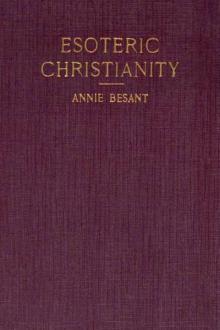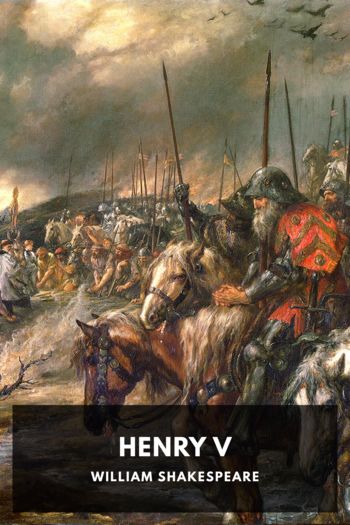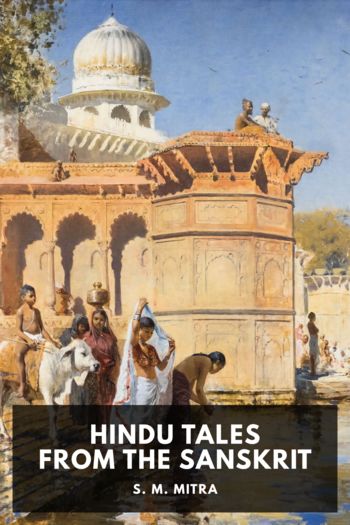Esoteric Christianity by Annie Besant (interesting books to read for teens .txt) 📕

- Author: Annie Besant
- Performer: -
Book online «Esoteric Christianity by Annie Besant (interesting books to read for teens .txt) 📕». Author Annie Besant
When the Trinity is represented as a Unity, the Triangle is used, either inscribed within a circle, or free. The universe is symbolised by two triangles interlaced, the Trinity of Spirit with the apex of the triangle upward, the Trinity of Matter with the apex of the triangle downward, and if colours are used, the first is white, yellow, golden or flame-coloured, and the second black, or some dark shade.
The kosmic process can now be readily followed. The One has become Two, and the Two Three, and the Trinity is revealed. The Matter of the universe is marked out and awaits the action of Spirit. This is the "in the beginning" of Genesis, when "God created the heaven and the earth,"[276] a statement further elucidated by the repeated phrases that He "laid the foundations of the earth;"[277] we have here the marking out of the material, but a mere chaos, "without form and void."[278]
On this begins the action of the Creative Intelligence, the Holy Spirit, who "moved upon the face of the waters,"[279] the vast ocean of matter. Thus His was the first activity, though He was the Third Person—a point of great importance.
In the Mysteries this work was shown in its detail as the preparation of the matter of the universe, the formation of atoms, the drawing of these together into aggregates, and the grouping of these together into elements, and of these again into gaseous, liquid, and solid compounds. This work includes not only the kind of matter called physical, but also all the subtle states of matter in the invisible worlds. He further as the "Spirit of Understanding" conceived the forms into which the prepared matter should be shaped, not building the forms, but by the action of the Creative Intelligence producing the Ideas of them, the heavenly prototypes, as they are often called. This is the work referred to when it is written, He "stretched out the heaven by His Understanding."[280]
The work of the Second Person follows that of the Third. He by virtue of His Wisdom "established the world,"[281] building all globes and all things upon them, "all things were made by Him."[282] He is the organising Life of the worlds, and all beings are rooted in Him.[283] The life of the Son thus manifested in the matter prepared by the Holy Spirit—again the great "Myth" of the Incarnation—is the life that builds up, preserves, and maintains all forms, for He is the Love, the attracting power, that gives cohesion to forms, enabling them to grow without falling apart, the Preserver, the Supporter, the Saviour. That is why all must be subject to the Son,[284] all must be gathered up in Him, and why "no man cometh unto the Father but by" Him.[285]
For the work of the First Person follows that of the Second, as that of the Second follows that of the Third. He is spoken of as "the Father of Spirits,"[286] the "God of the Spirits of all flesh,"[287] and His is the gift of the divine Spirit, the true Self in man. The human Spirit is the outpoured divine Life of the Father, poured into the vessel prepared by the Son, out of the materials vivified by the Spirit. And this Spirit in man, being from the Father—from whom came forth the Son and the Holy Spirit—is a Unity like Himself, with the three aspects in One, and man is thus truly made "in our image, after our likeness,"[288] and is able to become "perfect, even as your Father which is in heaven is perfect."[289]
Such is the kosmic process, and in human evolution it is repeated; "as above, so below."
The Trinity of the Spirit in man, being in the divine likeness, must show out the divine characteristics, and thus we find in him Power, which, whether in its higher form of Will or its lower form of Desire, gives the impulse to his evolution. We find also in him Wisdom, the Pure Reason, which has Love as its expression in the world of forms, and lastly Intelligence, or Mind, the active shaping energy. And in man also we find that the manifestation of these in his evolution is from the third to the second, and from the second to the first. The mass of humanity is unfolding the mind, evolving the intelligence, and we can see its separative action everywhere, isolating, as it were, the human atoms and developing each severally, so that they may be fit materials for building up a divine Humanity. To this point only has the race arrived, and here it is still working.
As we study a small minority of our race, we see that the second aspect of the divine Spirit in man is appearing, and we speak of it in Christendom as the Christ in man. Its evolution lies, as we have seen, beyond the first of the Great Initiations, and Wisdom and Love are the marks of the Initiate, shining out more and more as he develops this aspect of the Spirit. Here again is it true that "no man cometh to the Father but by Me," for only when the life of the Son is touching on completion can He pray: "Now, O Father, glorify Thou Me with Thine own Self, with the glory which I had with Thee before the world was."[290] Then the Son ascends to the Father and becomes one with Him in the divine glory; He manifests self-existence, the existence inherent in his divine nature, unfolded from seed to flower, for "as the Father hath life in Himself, so hath He given to the Son to have life in Himself."[291] He becomes a living self-conscious Centre in the Life of God, a Centre able to exist as such, no longer bound by the limitations of his earlier life, expanding to divine consciousness, while keeping the identity of his life unshaken, a living, fiery Centre in the divine Flame.
In this evolution now lies the possibility of divine Incarnations in the future, as this evolution in the past has rendered possible divine Incarnations in our own world. These living Centres do not lose Their identity, nor the memory of Their past, of aught that They have experienced in the long climb upwards; and such a Self-conscious Being can come forth from the Bosom of the Father, and reveal Himself for the helping of the world. He has maintained the union in Himself of Spirit and Matter, the duality of the Second Person—all divine Incarnations in all religions are therefore connected with the Second Person in the Trinity—and hence can readily re-clothe Himself for physical manifestation, and again become Man. This nature of the Mediator He has retained, and is thus a link between the celestial and terrestrial Trinities, "God with us"[292] He has ever been called.
Such a Being, the glorious fruit of a past universe, can come into the present world with all the perfection of His divine Wisdom and Love, with all the memory of His past, able by virtue of that memory to be the perfect Helper of every living Being, knowing every stage because He has lived it, able to help at every point because He has experienced all. "In that He Himself hath suffered being tempted, He is able to succour them that are tempted."[293]
It is in the humanity behind Him that lies this possibility of divine Incarnation; He comes down, having climbed up, in order to help others to climb the ladder. And as we understand these truths, and something of the meaning of the Trinity, above and below, what was once a mere hard unintelligible dogma becomes a living and vivifying truth. Only by the existence of the Trinity in man is human evolution intelligible, and we see how man evolves the life of the intellect, and then the life of the Christ. On that fact mysticism is based, and our sure hope that we shall know God. Thus have the Sages taught, and as we tread the Path they show, we find that their testimony is true.
Chapter X. PRAYER.[294]What is sometimes called "the modern spirit" is exceedingly antagonistic to prayer, failing to see any causal nexus between the uttering of a petition and the happening of an event, whereas the religious spirit is as strongly attached to it, and finds its very life in prayer. Yet even the religious man sometimes feels uneasy as to the rationale of prayer; is he teaching the All-wise, is he urging beneficence on the All-Good, is he altering the will of Him in "whom is no variableness, neither shadow of turning?"[295] Yet he finds in his own experience and in that of others "answers to prayer," a definite sequence of a request and a fulfilment.
Many of these do not refer to subjective experiences, but to hard facts of the so-called objective world. A man has prayed for money, and the post has brought him the required amount; a woman has prayed for food, and food has been brought to her door. In connection with charitable undertakings, especially, there is plenty of evidence of help prayed for in urgent need, and of speedy and liberal response. On the other hand, there is also plenty of evidence of prayers left unanswered; of the hungry starving to death, of the child snatched from its mother's arms by disease, despite the most passionate appeals to God. Any true view of prayer must take into account all these facts.
Nor is this all. There are many facts in this experience which are strange and puzzling. A prayer that perhaps





Comments (0)